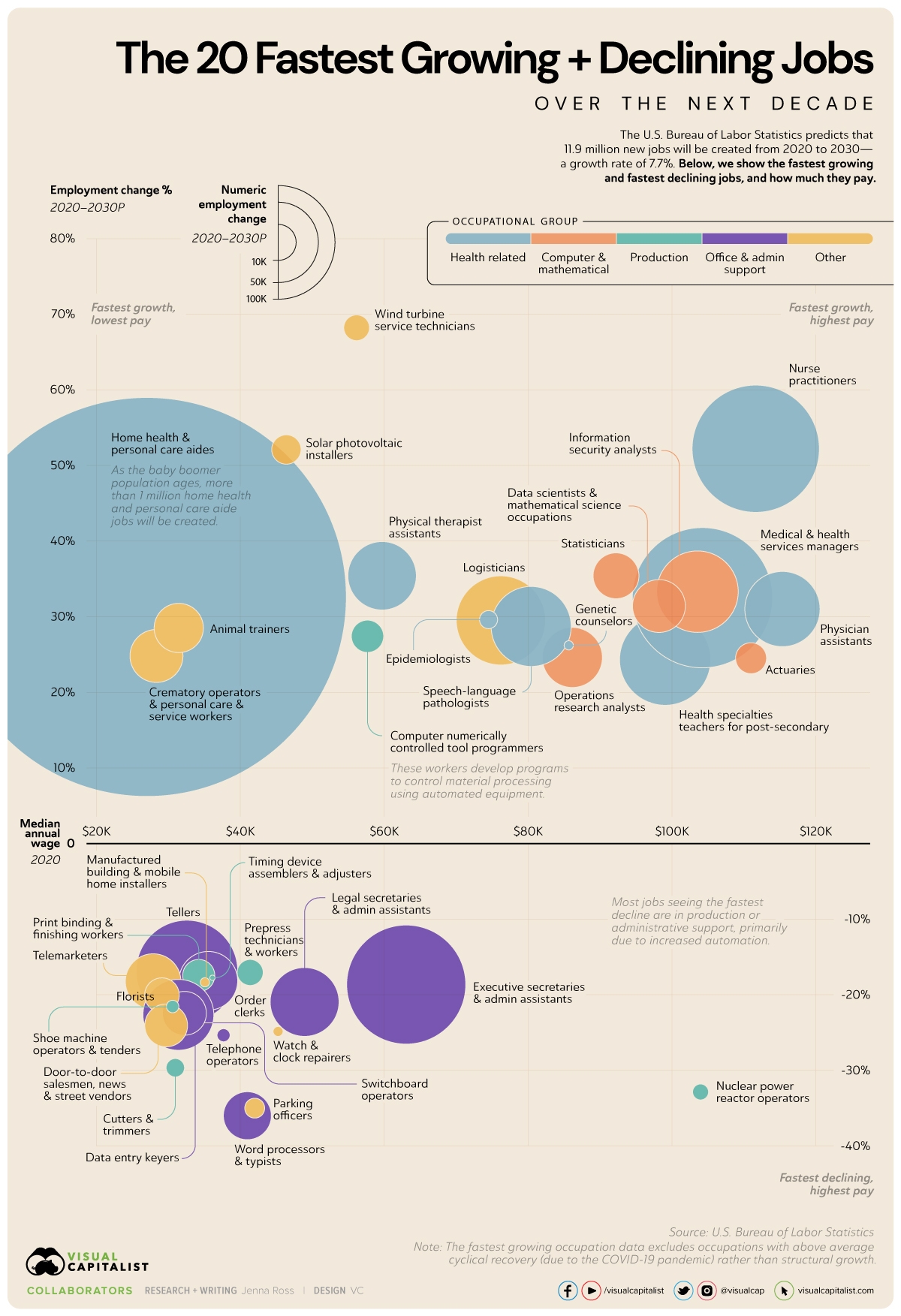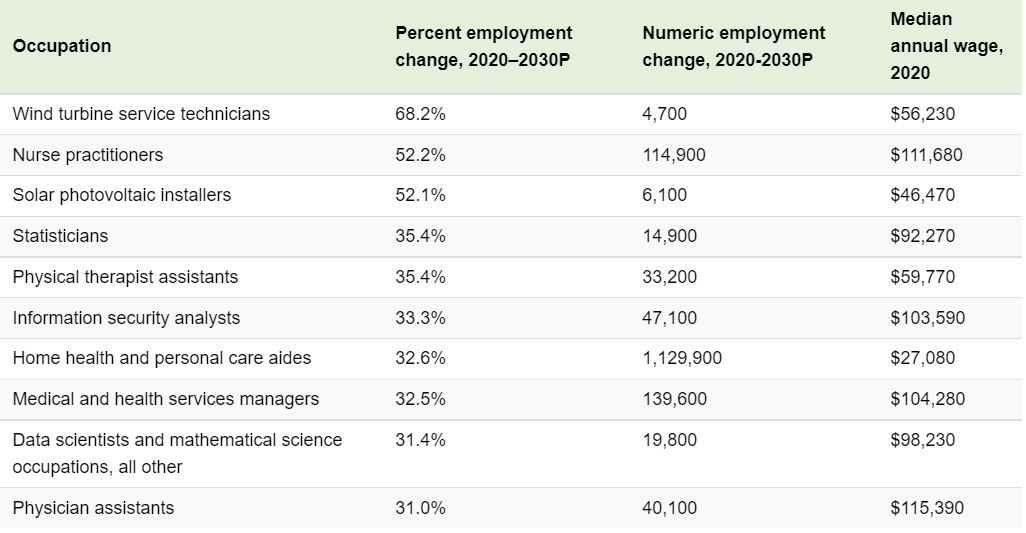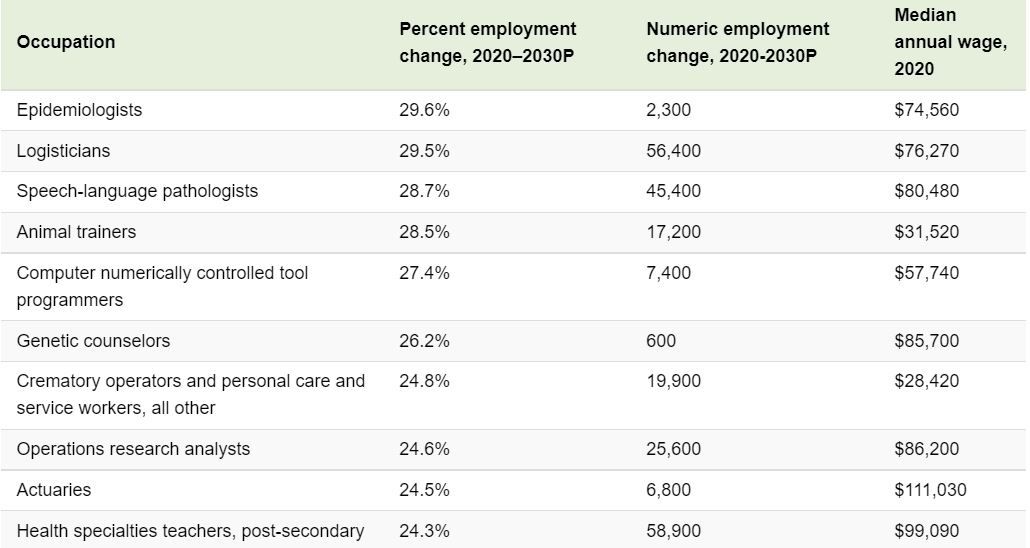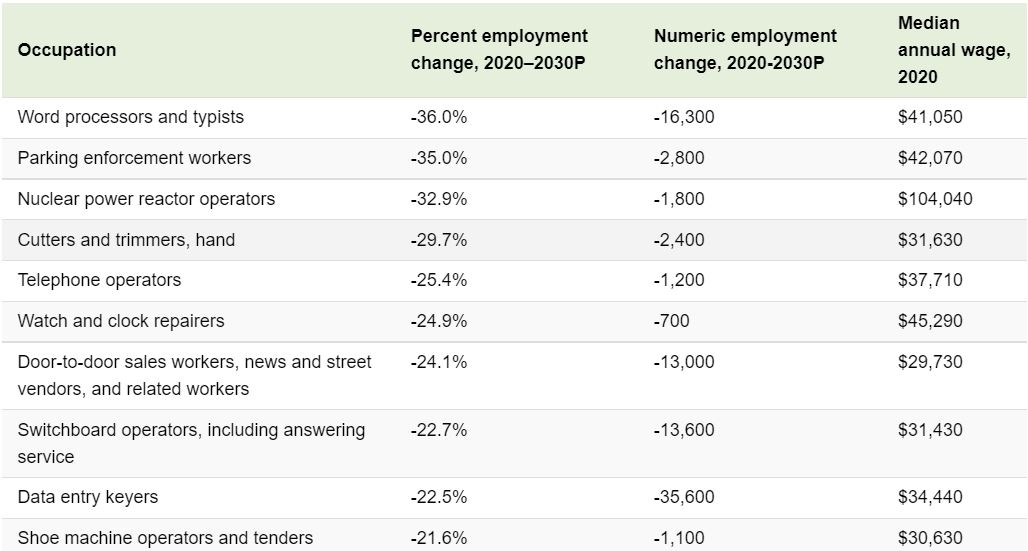Top 20 Fastest Growing and Declining Jobs in the Next Decade
 |
| Jobs in the next market. Photo: KnowInsiders |
If you are starting out your career or have been in the workforce for a while, it's important to look into the job future.
During the pandemic, workers in the leisure and hospitality space were one of first to lose their jobs or get furloughed. Now, due to nearly insatiable demand, the jobs have come roaring back. The bounceback has been so enormous that restaurants and businesses complain they can’t find enough workers. Large corporations, such as Walmart, Amazon and Target, have had to respond by offering sign-on bonuses, increases in wages and free tuition to entice people to join their companies.
The Shifting of Job Market in the Next Decade
Those who have lost their jobs through outsourcing, layoffs, or cutbacks, especially during the COVID-19 pandemic, are facing second — and even third — career choices, and possibly having to go back to school to get the necessary degrees. New college grads are struggling to find entry-level jobs that use their skills. Older workers are being talked into early retirement. Even those who are gainfully employed are seeking to get out of jobs that offer little in terms of salary advancement.
 |
| Photo: Visual Capitalist |
Some careers, however, show there is light at the end of the tunnel. Many of them reflect our fascination with, and our increasing dependence upon, technology. Some grow from the push for new, renewable energy sources, and some build further on our need for established energy sources. Others have to do with the changing demographics of our country, as the baby boomer generation continues to age. Regardless, there are plenty of available, lucrative, and rewarding career options on the table for determined American job seekers.
| The employment landscape is constantly shifting. While agricultural jobs played a big role in the 19th century, a large portion of U.S. jobs today are in administration, sales, or transportation. So how can job seekers identify the fastest growing jobs of the future? The U.S. Bureau of Labor Statistics (BLS) projects there will be 11.9 million new jobs created from 2020 to 2030, an overall growth rate of 7.7%. However, some jobs have a growth rate that far exceeds this level. In this graphic, we use BLS data to show the fastest growing jobs—and fastest declining jobs—and how much they each pay. |
The Top 20 Fastest Growing Jobs
Here are the fastest growing jobs from 2020 to 2030, along with the number of jobs that will be created and the median pay for the position.
 |
| Photo: Screenshot of Visual Capitalist |
 |
| Photo: Screenshot of Visual Capitalist |
Nine of the top 20 fastest growing jobs are in healthcare or related fields, as the baby boomer population ages and chronic conditions are on the rise. Home health and personal care aides, who assist with routine healthcare tasks such as bathing and feeding, will account for over one million new jobs in the next decade. This will be almost 10% of all new jobs created between 2020 and 2030. Unfortunately, these workers are the lowest paid on the list.
Computer and math-related jobs are also expected to see high growth. The BLS expects strong demand for IT security and software development, partly because of the increase in people that are working from home.
Wind Turbine Service Technicians
Stemming from the push for renewable energy, wind turbine service technicians are in high demand, with the profession projected to grow by 61% over the next decade. That demand results in a large number of job openings for qualified individuals seeking to enter the field.
Like solar photovoltaic installers, wind turbine service technicians are in the business of installing, maintaining, and repairing renewable energy systems. Individuals in this profession must possess a detailed knowledge of wind turbine systems and their operation. Wind turbine service technicians inspect and maintain wind turbines, ensuring their successful functioning, perform routine tests, replace worn or broken parts, collect and analyze data on systems, and service underground systems that convey energy from the turbines to collection facilities.
To become a wind turbine service technician, individuals must earn a minimum of a postsecondary non-degree award, such as a certificate or diploma in wind turbine maintenance, from a college or technical school. Additionally, individuals receive on-the-job training. Wind turbine service technicians work for electrical power and utilities companies, repair services, and technical services. Some are self-employed. Those in the field may need to work odd hours to service out-of-commission turbines in remote locations and bad weather. Employment for the profession is determined by location, with most wind turbine systems being established in windy, open areas, such as California, Texas, and Iowa.
Nurse Practitioners
Also known as advanced practice registered nurses (APRNs), nurse practitioners provide advanced nursing services to a variety of patients. Similar to, though not as advanced as a doctor, nurse practitioners can act as primary or specialty care providers, assessing patient needs and prescribing care plans. The regular duties of the profession include performing physical exams, performing and analyzing tests, create care plans, prescribing and administering medication, and consulting with doctors and other medical professionals. Like doctors, nurse practitioners practice in specific areas of medicine, such as general medicine, pediatrics, or geriatrics.
Nurse practitioners must have advanced medical knowledge in order to practice, earned through a master’s degree program in at least one specialized nursing role. Additionally, individuals must earn a registered nursing license in accordance with the state board, and have passed the national certification exam. Further education can aid in specialization. Nurse practitioners may find employment in a variety of settings, including hospitals, private clinics, and residential care facilities.
Solar Photovoltaic Installers
The recent, strong global push for renewable and sustainable energy sources has resulted in a booming job market for skilled professionals in the field. Specifically, the demand for solar energy has established solar photovoltaic installers as the career field with the highest projected growth for the next decade, at an astonishing 105.3%.
Solar photovoltaic installers, to simplify a complicated job title, install solar panels and solar panel systems. Also known as PV installers, professionals in this field plan systems according to client needs, install systems on buildings, houses, in fields, and other locations, connect panels to electrical systems, trouble shoot and perform maintenance, and more.
To enter the profession, individuals typically need a higher school diploma or equivalent; most of the knowledge and skills needed are learned through on-the job training, which may last up to a year. While certification is not necessary, employers may prefer it. Individuals can earn certification through the Electronics Technicians Association International (ETA), the North American Board of Certified Energy Practitioners (NABCEP), and Roof Integrated Solar Energy Inc. (RISE). Solar photovoltaic installers may be employed by plumbing or HVAC contractors, electrical contractors, utilities companies, hardware retailers, or may be self-employed.
The Top 20 Fastest Declining Jobs
Structural changes in the economy will cause some jobs to decline quite quickly. Here are the top 20 jobs where employment is expected to decline the fastest over the next decade.
 |
| Photo: Screenshot of Visual Capitalist |
 |
| Photo: Screenshot of Visual Capitalist |
At the opposite end of the scale, the roles which are set to be increasingly redundant by 2025 remain largely consistent with the job roles identified in 2018 and across a range of research papers on the automation of jobs. These include roles which are being displaced by new technologies.
Such job disruption is counter-balanced by job creation in new fields, the ‘jobs of tomorrow’. Over the coming decade, a non-negligible share of newly created jobs will be in wholly new occupations, or existing occupations undergoing significant transformations in terms of their content and skills requirements.
Eight of the top 20 declining jobs are in office and administrative support. This could be cause for concern, given this category currently makes up almost 13% of employment in the U.S.—the largest of any major category. Jobs involved in the production of goods and services, as well as sales jobs, are also seeing declines.
The word processing and typing industry and its workers will be hit the hardest overall over the next decade, with over a third — 36 percent — expected to lose their jobs.
Among the top 10 fastest declining jobs, data entry keyers are expected to lose the highest number — 35,600 — of individual workers.
Education Required
As the composition of employment shifts, it eliminates some jobs and creates others. For instance, while production jobs are declining, new opportunities exist for “computer numerically controlled tool programmers.” These workers develop programs to control the automated equipment that processes materials.
However, while many of the fastest growing jobs are higher paying, they typically also require advanced education.
Seventeen of the top 20 fastest growing jobs have a median salary higher than $41,950, which is the median salary for all jobs in total. Most also require post-secondary schooling. These opportunities are replacing jobs that only required a high school diploma.
With tuition costs soaring relative to inflation, this could create challenges for displaced workers or young people entering the workforce.
| This resulting set of emerging professions reflects the adoption of new technologies and increasing demand for new products and services, which are driving greater demand for green economy jobs, roles at the forefront of the data and AI economy, as well as new roles in engineering, cloud computing and product development. In addition, the emerging professions showcase the continuing importance of human interaction in the new economy through roles in the care economy; in marketing, sales and content production; as well as roles where a facility or aptitude for understanding and being comfortable working with different types of people from different backgrounds is critical. |
 Top 10 Most Dangerous Jobs in UK Top 10 Most Dangerous Jobs in UK The job market in the Uk varies in numerous fields. Right below is a list of 10 most dangerous jobs in the Uk. |
 Top 10 Weirdest & Rarest Jobs in the World Of All Time Top 10 Weirdest & Rarest Jobs in the World Of All Time You might not know that there are tons of strangest careers around the world in history, but they did exist. Curious? Tuning the top 10 ... |
 Top 10 Weirdest & Rarest Jobs In The World Today Top 10 Weirdest & Rarest Jobs In The World Today Have you ever thought of these strangest careers such as fake facebooker, nail polish namer, professional sleeper, etc. Yes, they are the rarest and weirdest ... |


























